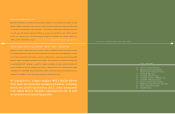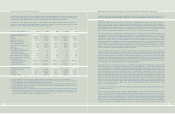Ingram Micro 2001 Annual Report Download - page 20
Download and view the complete annual report
Please find page 20 of the 2001 Ingram Micro annual report below. You can navigate through the pages in the report by either clicking on the pages listed below, or by using the keyword search tool below to find specific information within the annual report.
Notes to Consolidated Financial Statements
(Dollars in 000s, except per share data)
Goodwill
Goodwill represents the excess of the purchase price over the fair value of the identifiable net assets acquired in an acquisition accounted
for using the purchase method, and is amortized on a straight-line basis over periods ranging from 10 to 30 years. Accumulated amortization
was $97,523 at December 29, 2001 and $76,560 at December 30, 2000.
Investments in Available-for-Sale Securities
The Company classifies its existing marketable equity securities as available-for-sale in accordance with the provisions of Statement
of Financial Accounting Standards No. 115, “Accounting for Certain Investments in Debt and Equity Securities.” These securities are
carried at fair market value, with unrealized gains and losses reported in stockholders’ equity as a component of accumulated other
comprehensive income (loss). Realized gains or losses on securities sold are based on the specific identification method.
In December 1998, the Company purchased 2,972,400 shares of common stock of SOFTBANK Corp. (“Softbank”), Japan’s largest
distributor of software, peripherals and networking products, for approximately $50,262. During December 1999, the Company sold
1,040,400 shares or approximately 35% of its original investment in Softbank common stock for approximately $230,109 resulting in
a pre-tax gain of approximately $201,318, net of related expenses. In January 2000, the Company sold an additional 445,800 shares
or approximately 15% of its original holdings in Softbank common stock for approximately $119,228, net of expenses, resulting in a
pre-tax gain of approximately $111,458. The realized gains, net of expenses, associated with the sales of Softbank common stock in
January 2000 and December 1999 totaled $69,327 and $125,220, respectively, net of deferred taxes of $42,131 and $76,098, respectively
(see Note 8). The Company used the net proceeds from the sales primarily to repay existing indebtedness. During April 2000, Softbank
effected a 3 for 1 stock split. All Softbank share information has been adjusted to give retroactive effect to Softbank’s stock split.
In connection with the December 1999 sale of Softbank common stock, the Company issued warrants to Softbank for the purchase of
1,500,000 shares of the Company’s Class A Common Stock with an exercise price of $13.25 per share, which approximated the market price
of the Company’s common stock on the warrant issuance date. The warrants were exercisable immediately and have a five-year term. The
estimated fair value of these warrants upon issuance was approximately $11,264 and was determined using the Black-Scholes option-pricing
model using the following assumptions:
Risk-free interest rate 6.27%
Term of warrant 5 years
Expected stock volatility 55.4%
The estimated fair value of the warrants has been included in other expenses in the Company’s consolidated statement of income for fiscal 1999.
At December 29, 2001 and December 30, 2000, the unrealized holding gain (loss) associated with the Softbank common stock totaled
($672) and $16,965, respectively, net of ($428) and $10,801, respectively, in deferred income taxes.
Concentration of Credit Risk
Financial instruments that potentially subject the Company to significant concentrations of credit risk consist principally of trade
accounts receivable and derivative financial instruments. Credit risk with respect to trade accounts receivable is limited due to the large
number of customers and their dispersion across geographic areas. No single customer accounts for 10% or more of the Company’s net
sales. The Company performs ongoing credit evaluations of its customers’ financial conditions, obtains credit insurance in certain
locations and requires collateral in certain circumstances. The Company maintains an allowance for potential credit losses.
Derivative Financial Instruments
The Company operates internationally with distribution facilities in various locations around the world. The Company reduces its exposure
to fluctuations in interest rates and foreign exchange rates by creating offsetting positions through the use of derivative financial
instruments. The market risk related to the foreign exchange agreements is offset by changes in the valuation of the underlying items
being hedged. The majority of the Company’s derivative financial instruments have terms of 90 days or less. The Company currently
does not use derivative financial instruments for trading or speculative purposes, nor is the Company a party to leveraged derivatives.
37
Notes to Consolidated Financial Statements
(Dollars in 000s, except per share data)
Foreign Currency Translation and Remeasurement
Financial statements of foreign subsidiaries, for which the functional currency is the local currency, are translated into United States
(“U.S.”) dollars using the exchange rate at each balance sheet date for assets and liabilities and a weighted average exchange rate for each
period for statement of income items. Translation adjustments are recorded in accumulated other comprehensive income, a component of
stockholders’ equity. The functional currency of the Company’s subsidiaries in Latin America and certain countries within the Company’s
Asia-Pacific operations is the U.S. dollar; accordingly, the monetary assets and liabilities of these subsidiaries are translated into U.S.
dollars at the exchange rate in effect at the balance sheet date. Revenues, expenses, gains or losses are translated at the average exchange
rate for the period, and nonmonetary assets and liabilities are translated at historical rates. The resultant remeasurement gains and
losses of these subsidiaries are recognized in the consolidated statement of income. Gains and losses from foreign currency transactions
are included in the consolidated statement of income. Included in other expenses was $5,204, $3,322 and $2,583 in 2001, 2000, and 1999,
respectively, which represented net foreign exchange losses resulting from remeasurement and foreign exchange transactions.
Fair Value of Financial Instruments
The carrying amounts of cash, accounts receivable, accounts payable and other accrued expenses approximate fair value because of the
short maturity of these items. The carrying amounts of outstanding debt issued pursuant to bank credit agreements approximate fair
value because interest rates over the relative term of these instruments approximate current market interest rates. At December 29, 2001,
the Senior Subordinated Notes’ carrying value of $204,899 approximates its fair market value. The estimated fair value of the Zero Coupon
Convertible Senior Debentures including original issue discount was $405 and $219,323 at December 29, 2001 and December 30, 2000,
respectively, based upon quoted market prices. The carrying value at December 29, 2001 and at December 30, 2000 was $405 and
$220,035, respectively.
Cash and Cash Equivalents
The Company considers all highly liquid investments with original maturities of three months or less to be cash equivalents. Book
overdrafts of $162,286 and $184,945 as of December 29, 2001 and December 30, 2000, respectively, are included in accounts payable.
Inventories
Inventories are stated at the lower of average cost or market.
Long-Lived and Intangible Assets
The Company assesses potential impairments to its long-lived and intangible assets when there is evidence that events or changes in
circumstances have made recovery of the asset’s carrying value unlikely. An impairment loss would be recognized when the sum of the
expected, undiscounted future net cash flows is less than the carrying amount of the asset. The amount of an impairment loss would be
recognized as the excess of the asset’s carrying value over its fair value.
Property and Equipment
Property and equipment are recorded at cost and depreciated using the straight-line method over the following estimated useful lives.
The Company also capitalizes computer software costs that meet both the definition of internal-use software and defined criteria for
capitalization in accordance with Statement of Position No. 98-1, “Accounting for the Cost of Computer Software Developed or Obtained
for Internal Use.” Leasehold improvements are amortized over the shorter of the lease term or the estimated useful life:
Buildings 40 years
Leasehold improvements 3-17 years
Distribution equipment 5-7 years
Computer equipment and software 2-8 years
Maintenance, repairs and minor renewals are charged to expense as incurred. Additions, major renewals and betterments to property
and equipment are capitalized.
36























